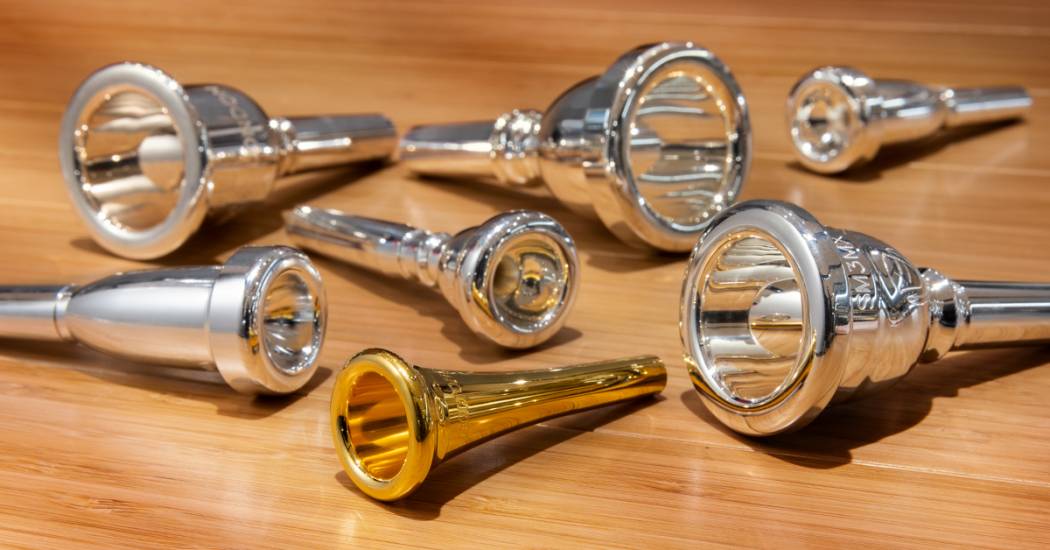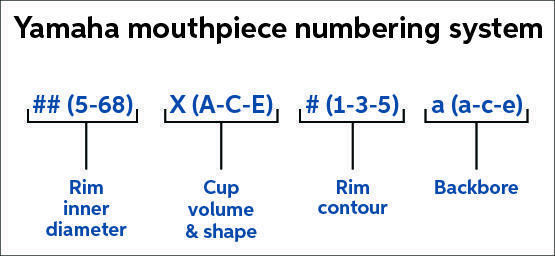
Whether you’re an aspiring brass player or you’ve been playing for years, Sweetwater’s Brass Instrument Mouthpiece Buying Guide can help you select the right mouthpiece to fit your needs.
Brass-instrument mouthpieces come in an incredible variety of shapes tailored to fit individual players’ embouchures, dental structures, and desired sound. Sorting through the myriad options can be daunting, but this guide will provide you with the basic knowledge you need to begin narrowing down your choices. In this guide, we’ll cover the following topics:
Mouthpiece Materials
Generally, brass-instrument mouthpieces are crafted from brass due to its workability and inherently pleasing acoustic properties. To protect against damage and wear and tear and to provide a comfortable feel, mouthpieces feature a plated finish. Silver plating is by far the most common option. However, some mouthpieces boast gold plating either entirely or just around the cup or rim. There are no sonic differences between silver and gold plating, but gold is less prone to tarnishing, and some players attest that it has a more satisfying feel.
Mouthpiece Components
The structure of a mouthpiece can be organized into four basic sections: rim, cup, throat, and backbore (interior)/shank (exterior).
Rim
The rim of the mouthpiece is the point where your lips contact the mouthpiece, and it comes in a range of widths, inner rim contours, and bites to accommodate many different embouchures.
Inner rim diameter
The inner rim diameter is often referred to in the mouthpiece’s model number, and the size difference between mouthpieces can be very small — often within fractions of a millimeter. Rims with small inner diameters require less endurance and are excellent at facilitating playing in high registers. However, they can restrict overall volume and projection. Mouthpieces with large rim diameters require more effort to play, but they boast ample volume and projection and assist with producing stable notes in lower registers.
| Inner Rim Diameter | Characteristics |
| Large | Increases volume, control |
| Small | Relieves fatigue, weakness |
Rim contour and bite
Rim contour refers to the shape and thickness of a mouthpiece’s rim. A wide rim with a flat surface provides more area for your lips to contact, which makes playing high notes easier and which can be beneficial for players with limited endurance. There is a cost, though, in terms of the diversity of tones you can produce. Conversely, a thin or narrow rim delivers a more flexible playing experience and opens up opportunities for advanced articulations and expressions. Yet, mouthpieces with narrow rims require considerably more endurance and can be fatiguing for inexperienced players.
Another factor to consider is rim bite, which denotes the sharpness of the rim’s inside corner. A sharp bite, or a steep curve, enables players to accurately sound notes, to hold a stable pitch, and to generate a rich, full-bodied tone. That said, some players may find that a rim with too sharp of a bite can limit their lip control, cause fatigue, and make it more difficult to play slurred notes and legato passages. Rims with a very soft bite can improve playability in terms of comfort but may negatively impact pitch definition and the ability to produce a crisp attack.
When purchasing your first mouthpiece, Sweetwater suggests choosing one with a medium-wide inner diameter and a medium thickness. As you progress, we encourage experimenting with different mouthpieces to find which works best for your embouchure and playing style.
| Rim Contour | Characteristics |
| Wide | Increases endurance |
| Narrow | Improves flexibility and range |
| Round | Improves comfort |
| Sharp | Increases brilliance and precision of attack |
Cup
A mouthpiece’s cup also comes in a variety of depths and shapes to fit the requirements of diverse players.
Cup depth
The depth of the mouthpiece’s cup has much the same influence on the character of the mouthpiece as the inner rim diameter. A shallow cup is ideal for easily accessing the high register and contributes brightness to the overall sound of your horn, but it can be limiting when it comes to volume and projection. On the flip side, a deep cup will offer a darker sound, excellent playability in the low register, and plenty of volume, but it requires more energy to cleanly produce high notes.
| CUP DEPTH | Characteristics |
| Deep | Darkens tone, especially in the low register |
| Shallow | Brightens tone, improves response, especially in the high register |
Cup shape
Cup shape can vary from mouthpiece to mouthpiece, but they generally fall under two types: U cups and V cups. The U cup (which is sometimes called a C-type cup or bowl cup) requires players to push more air into the throat of the mouthpiece, but it rewards them with a brilliant, projective tone. The V cup has a conical taper that helps direct air into the mouthpiece’s throat, meaning it requires less effort to produce a stable tone and allows easier playability of notes in the upper register. V-cup mouthpieces have additional variations focused on the shape of the cup taper, including straight, convex, and concave tapers.
Throat
The throat is the narrow opening at the bottom of the cup that leads to the backbore. Like the other elements we’ve discussed, throats come in many variations — you may be noticing a trend! Both the diameter and length of the throat have significant influence over the amount of air resistance you’ll experience with a mouthpiece. On one end of the spectrum, long and narrow throats push back with quite a bit of resistance, which focuses the air for a very responsive feel, a brighter sound, and effortless playing in the upper register. On the other end of the spectrum, throats that are short and wide provide less resistance to deliver a powerful sound and to facilitate low-note playing. However, they demand more air and energy from a player, which could tire you out if you’re a less-experienced player.
| Throat | Characteristics |
| Large | Increases blowing freedom, volume, tone; sharpens high register (largest sizes also sharpen low register) |
| Medium | Increases resistance, endurance, brilliance; flattens high register |
Backbore
The backbore is the longest interior chamber of the mouthpiece, beginning at the point where the throat starts to widen. Like the throat, narrower backbores are brighter and more resistant and can assist with high notes, while wider backbores contribute to a darker tone and highlight low notes. Some manufacturers, such as Yamaha, produce mouthpieces with a standard backbore, but there is no shortage of different backbore designs. Other manufacturers offer a wide selection of backbore sizes and shapes, even some that are uniquely sculpted to produce very specific tones.
Mouthpiece Sizing Charts
The most common commercially produced brass mouthpieces are made by Bach and Yamaha, and both manufacturers have their own sizing conventions and numbering systems.
Yamaha mouthpiece numbering system
The Yamaha mouthpiece numbering system is a relatively straightforward alphanumeric code related to four aspects of the mouthpiece design: backbore, rim contour, cup volume and shape, and inner rim diameter.

Bach mouthpiece numbering system
The Bach mouthpiece numbering system is more complex than the Yamaha system. It comprises numerous model numbers, which are matched with a numeral denoting the cup diameter.
| MODEL | DESCRIPTION |
| ** | Models with no letter designation have deep cups, #10 backbores, and a rich, full, clear tone |
| A | Very deep cup and #24 backbore; emit a large, dark sound |
| B | Medium-deep cups, #7 backbores, and a full, Teutonic tone with great volume |
| C | Medium cups, #10 backbores; preferred by many players that alternate between B♭, C, and D trumpet |
| D | Medium-shallow cups, #76 backbores; produce a sparkling, brilliant tone, especially in the high register; artists who continually play in the extreme high register use them to their advantage |
| E | Shallow cups, #117 backbores; designed for use on soprano and piccolo trumpets; also preferred by extreme-high-register players |
| F | Extra-shallow cups, #76 backbores; also preferred by extreme-high-register players |
| V | “V” designates a very deep cup, #20 throat, and #25 backbore”MV” designates a medium-deep cup, #25 throat, and #25 backbore”SV” designates a shallow cup, #25 throat, and #25 backbore |
| W | Wide, cushion rim for soft, thick lips |
Bach mouthpiece numbering system examples
To put the Bach mouthpiece numbering system into context, let’s look at two examples:
Example #1
Bach 7C mouthpiece
- The 7 denotes the cup diameter
- The C denotes a medium cup with a #10 backbore
Example #2
Bach 11EW mouthpiece
- The 11 denotes the cup diameter
- The E denotes a shallow cup with a #117 backbore
- The W denotes a wide, cushion rim
Shop Sweetwater Brass Mouthpieces
Sweetwater carries a large selection of brass mouthpieces to suit every player. Here are some of our most popular mouthpieces for brass instruments.
Popular mouthpieces for trumpets
Popular mouthpieces for trombones
Shop All Trombone Mouthpiecces
Popular mouthpieces for tubas
Popular mouthpieces for euphoniums
Shop All Euphonium Mouthpieces
Popular mouthpieces for French horn
Shop All French Horn Mouthpieces
Conclusion
No matter where you are on your musical journey, we’re here to help. Sweetwater has the most highly trained salespeople in the business. Call your Sweetwater Sales Engineer at (800) 222-4700; they’ll be happy to help find the best brass-instrument mouthpiece for you.














